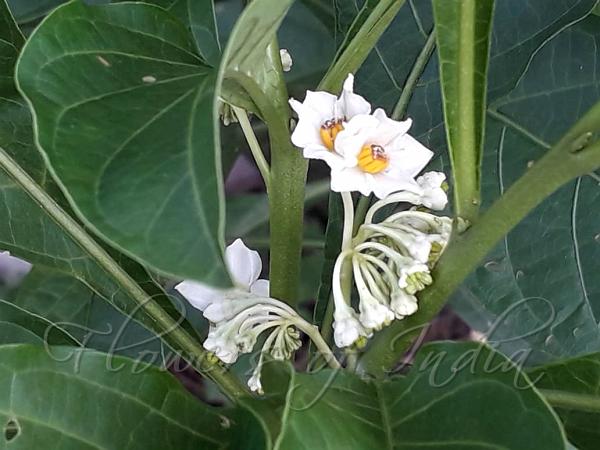|
| Spiral Nightshade |
|

|

|
|
|
|
Photo: |
Botanical name: Solanum spirale Family: Solanaceae (Potato family)
Synonyms: Solanum apoense, Solanum naratida
Synonyms: Solanum apoense, Solanum naratida
Spiral Nightshade is an evergreen shrub becoming
hairless, with stems erect, 0.5-3 m tall, drying grooved angled.
Flowers are borne in leaf opposed or extra-in leaf-axils, short, simple
spiral racemes. Flower-cluster-stalks are 3-12 mm, later bearing
prominent flower-stalk scars. Flower-stalks are 1.5-2.5 cm, deflexed at
anthesis. Calyx is 2-3 mm, (4- or) 5-lobed; sepals triangular, 0.5-1
mm. Flowers are white, 8-10 mm, lobed about 3/4 way to base. Filaments
are about 1 mm; anthers 3-3.5 mm. Style about 7 mm. Fruiting
flower-stalks are deflexed. Leaves are unequally paired; leaf-stalk
5-10 mm; blade of major leaf narrowly elliptic to elliptic, 9-22 x 4-11
cm, hairless above, base narrowed, margin entire, tip tapering; blade
of minor leaf, 5-7 x 1.6-3 cm. Berry is dull yellow-orange, spherical,
1.1-1.6 cm in diameter. Seeds are yellow or tan, kidney-shaped-discoid,
3-3.5 x 2.5-3 mm. Tender leaves are locally eaten in Yunnan and NE
India as a vegetable. Fruit eaten both raw and cooked. Spiral
Nightshade is found in NE India, China, Myanmar, Thailand, Laos,
Vietnam, Bhutan, Bangladesh, at altitudes of 500-1900 m. Flowering:
May-July.
Medicinal uses: The roots are used as an
anaesthetic and diuretic. The bark is broken and soaked in cold water,
then used as a febrifuge for adults and infants.
The roots are used as an
anaesthetic and diuretic. The bark is broken and soaked in cold water,
then used as a febrifuge for adults and infants.
Medicinal uses:
 The roots are used as an
anaesthetic and diuretic. The bark is broken and soaked in cold water,
then used as a febrifuge for adults and infants.
The roots are used as an
anaesthetic and diuretic. The bark is broken and soaked in cold water,
then used as a febrifuge for adults and infants. | Identification credit: Tabish | Photographed in East Siang district, Arunachal Pradesh, Langol, Manipur. |
• Is this flower misidentified? If yes,